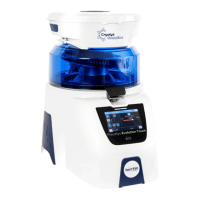Page 11Page 10
PRECELLYS EVOLUTION
PRECELLYS
®
Evolution Touch
USER MANUAL
1
2
3
4
8
9
12
11
13
14
10
5
6
7
Figure 1 : Home screen
3.1.4 Présentation de l’interface de commande
The touch screen lights up when the PRECELLYS® Evolution Touch is
powered on and displays the main menu after a few seconds of system
boot up.
Lid: closes the equipment.
Locking handle: locks the Precellys® Evolution Touch lid and
prevents it from opening.
Human Machine Interface: allows the user to program and
start the protocols.
Tube blocking plate: blocks the lysing tubes inserted in the
tube holder.
Tube holder: supports the lysiing tubes.
Metal support: supports the tube holder.
Containment seal: allows the sealing of the Precellys® Evolu-
tion Touch.
Air inlet: diuses the air in the Precellys® Evolution Touch.
USB port: exports/imports data using a USB stick.
Additional 24V DC connection: allows the connection of a
Cryolys Evolution unit.
On/O button: turns the Precellys® Evolution Touch on and o
Power plug: connects the Precellys® Evolution Touch to the
power supply.
Fuse: protects the Precellys® Evolution Touch from power
surges.
Additional 3V - 5V DC connection: allows the connection of a
Cryolys Evolution unit.
1
2
3
4
5
6
7
8
9
14
10
12
11
13
3.1.2 Tube kinetics
Given the design and symmetry of the machine, each of the tubes of
the same type placed in the rack has strictly the same kinetics, which
guarantees the same quality of lysis and homogenization in each of the
tubes.
The centre of gravity of the tubes moves through a complex hemispherical-
shaped pathway. The mixture contained in the tubes therefore undergoes
a three-dimensional motion that prioritizes vertical movements, thereby
ensuring the eciency of the lysis. The movement generated by the
PRECELLYS® Evolution Touch is a precessional motion, which means that
the tubes are not rotated.
The geometry of the tubes used must be compatible with the rack and be
able to withstand accelerations of 600 g for 5 minutes without becoming
deformed (see recommendations for use § 2.6.1).
The precessional motion undergone by the biological samples causes the
temperature of the sample and apparatus to rise.
3.1.3 Description of the equipment

